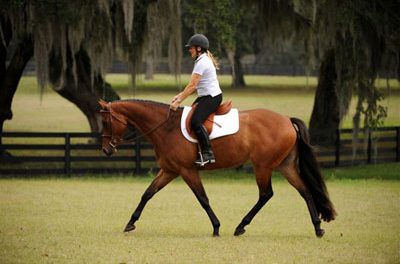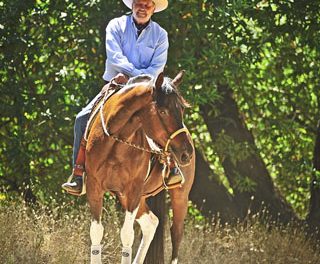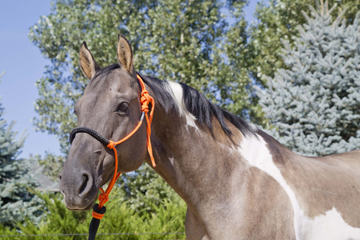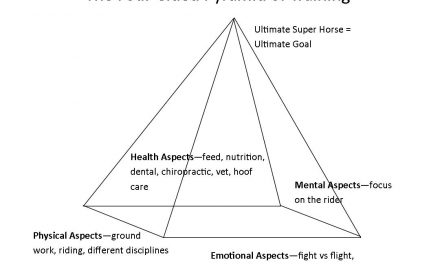Ask Julie Goodnight
 Question: Dear Julie, I usually ride some type of warmblooded horse (not exactly sure of the exact type) during riding classes. He’s often very nervous about a certain corner of the riding circle. He was once spooked by a bird, and since that he’s been trying to avoid that corner/short side. The horse trainer told me to avoid the corner to make him calmer, but what happened was that while trotting near that particular corner (short side of the circle), he suddenly spooked and ran off. I managed to stop him, but because of his action another girl fell off her horse. I guess he was already quite tense because of approaching the corner and when I turned him away from the corner, I must have somehow confirmed that the corner was a dangerous place? He was quite nervous during the rest of the class. Just by removing my feet from the stirrups he got very tense. I feel sorry for him because it seemed to be a true reaction of fear/shock.
Question: Dear Julie, I usually ride some type of warmblooded horse (not exactly sure of the exact type) during riding classes. He’s often very nervous about a certain corner of the riding circle. He was once spooked by a bird, and since that he’s been trying to avoid that corner/short side. The horse trainer told me to avoid the corner to make him calmer, but what happened was that while trotting near that particular corner (short side of the circle), he suddenly spooked and ran off. I managed to stop him, but because of his action another girl fell off her horse. I guess he was already quite tense because of approaching the corner and when I turned him away from the corner, I must have somehow confirmed that the corner was a dangerous place? He was quite nervous during the rest of the class. Just by removing my feet from the stirrups he got very tense. I feel sorry for him because it seemed to be a true reaction of fear/shock.
I’d like to ride him again next time, but being a fresh rider, I’m not sure how I should handle his sudden spooks. The first time I noticed his nervousness was when riding outdoors. A paper sign was moving because of the wind and he suddenly jumped to the side. Do you think I should get another horse? Is it okay to pet him/reward him for settling down after an incident like that, or will he then think that I rewarded him for spooking? How long a memory does a horse have regarding reward? I don’t want to force him to go into that scary corner. Is there another way to make him overcome that fear or general nervousness?
Thanks for teaching me a lot about horses and riding,
Kaja
Answer: Kaja, Horses can be very suspicious animals and when something has frightened them, they tend to remember it and every time they get to the place where they were scared, they will be expecting something scary to happen. Also, horses are very location-specific in the way they behave—associating a certain place with their behavior, so it is no surprise the way your horse is acting. Most every arena has a “scary” place in it and typically it is as far away from the gate or barn as you can get. This is no coincidence—the farther away from the barn (which represents the safety of the herd to him) he gets, the more unsure he becomes and the stronger the urge to run back to safety.
In some cases it may be good to avoid a trouble spot, like when you are first warming up a fresh (or volatile) horse or if you have questions about your ability to control the horse if he spooks. However, at some point, in order for you to have total control over your horse, you must be able to take him into places where he may not want to go, maintaining his obedience. If a horse comes to believe he has a say-so in where you try to take him, your authority will gradually erode to the point that you can’t get him out of the barnyard or around the arena.
When a horse is spooky or frightened, the best thing to do is turn him toward the scary object and ask him to stand, take a deep breath and relax. You should reassure your horse by using a soothing voice and rubbing him on the neck and taking a deep breath yourself; this will show him that you think everything is okay, that you have it all under control and he need not be afraid. Try to avoid turning your horse away from a scary object while he is still frightened because that will almost certainly trigger his flight response, as you have seen.
With an emotional or volatile horse like this, I would begin working in the “safest” part of the arena, using small circles and lots of changes of direction and building confidence and obedience in the horse. The more you change directions and cause the horse to swing his neck from side to side, the calmer and more compliant he will become (“S” turns are much more productive than circles). As the horse relaxes and gets more comfortable, I will start expanding the area I am working in by venturing toward the scary place gradually and always returning back to the “safe” place to build confidence. Eventually I would be working closer and closer to the scary spot until I could ride him in that area without a reaction from him.
There is a very effective technique to use when working with spooky horses. First, keep in mind that you will always have more control over a horse when his neck is bent; when it is straight out in front of him he can get away from you easily. So as you approach the scary area, you’ll want to keep his neck slightly bent to one side or the other. An easy way to accomplish this is to ride in a serpentine pattern doing constant changes of direction. But make sure that each and every time you turn him, you turn TOWARD the scary place and not away from it. You’ve already seen what happens when you turn away from a scary object— his flight response is triggered and your horse is likely to bolt. Weaving back and forth and turning him toward the scary spot will accomplish several things—it will keep his neck bent for greater control, it will keep him in an obedient frame of mind because he is responding to your directives and going where you said and it will put him a little closer to the object every time you turn him (and prevent him from bolting like he did when you turned him away from it). There are several articles in my Training Library about this process of despooking a horse. http://juliegoodnight.com/traininglibrary
Asking your horse to keep his head down will cause him to relax as well, but this may require the skill of a more advanced rider (again, check out my Training Library for more info on how to do this). From the sounds of it, this is not a great horse for a beginner rider and it would probably be more productive and more fun for you to ride a less volatile horse. That way you can relax and think about improving your own riding, instead of worrying about the next time he spooks. Remember, this is all about having fun. Your riding and your confidence will advance much faster on an easier horse and you may find that you’ll progress enough that you can eventually ride this horse again and have more confidence.
When a horse is frightened or spooky, he needs the rider’s calmness and reassurance to let him know he will be okay. I would put my hands down on a horse’s neck to steady him any time he became tense or unsure—it is not really a reward, just a reassurance that I’ve got everything under control. And I would give copious praise to my horse by petting him in the withers or neck when he is obedient and brave in the face of a scary thing. The rule of thumb with horses is that you have a three second window of opportunity to reward, release or punish the horse, in order for him to make an association between his actions and your actions—and the sooner in the three seconds the better. If a horse is rewarded in a timely fashion, he will remember it for a very long time. The important part is not whether or not he remembers the reward, it’s whether he made an association between his actions and the reward. If the association is made, he will remember it for some time—horses have exceptional memories.
As you have seen already, the more you learn about horses, the more you learn how much you don’t know, which is why advanced and expert riders are sometimes more humble than novice riders. This horse is challenging and no doubt you would learn a lot from him, but it may be better to ride something a little easier and safer for now so that you can focus on developing your riding skills without having to train a horse at the same time.
Good luck!
Julie
_________________________________
If you liked this article, Julie suggests the following products to help you continue the work with your horse (http://shop.juliegoodnight.com or call 800-225-8827 for ordering help):
The Goodnight’s Principles of Riding 5-Part DVD Series
Horse Master Air Schedule
SPECIAL NEWS! Watch Horse Master with Julie Goodnight at its new time on RFD-TV! Mondays at 12:30 and 10:30 p.m. EST, Fridays at 6:30 a.m. EST and Saturdays at 10:30 p.m. PST!
Week of June 20 HM 417
Julie Goodnight: “Follow the Leader.” On Horse Master: Teaching the horse to follow & turn toward you in the roundpen. (2011)
Week of June 27 HM409
Julie Goodnight: “Bucket List.” On Horse Master: Teaching a barrel horse to lower her head, collect. (2011)
Week of July 4 HM410
Julie Goodnight: “Troubled Waters.” On Horse Master: Teaching a trail rider to walk confidently through water. (2011)
Week of July 11 HM411
Julie Goodnight: “Cowboy Up.” On Horse Master: Teaching a teen to plan his horse’s workouts, build confidence. (2011)
Week of July 18 HM412
Julie Goodnight: “Break on Through.” On Horse Master: Re-training a horse that learned to run away on the longe and lead lines. (2011)
Week of July 25 HM413
Julie Goodnight: “Blowing in the Wind.” On Horse Master: Teaching a trail horse to ride right past scary objects. (2011)
Find more free articles to read and refer to in Julie’s Training Library: http://juliegoodnight.com/q&a.php and watch Horse Master on RFD-TV every Monday at 12:30 and 10:30p EST —Direct TV channel 345, Dish Network channel 231 and on many cable outlets. Then visit http://www.horsemaster.tv and http://www.juliegoodnight.com/clinics for the clinic schedule, articles related to each episode, the gear used in each show, and for training DVDs and publications. Plus, see clips from each show at: http://www.horsemaster.juliegoodnight.com and check out specials and even more clips on Goodnight’s Facebook Fan Page: http://www.facebook.com/horsemaster.tv. Sign up for the free monthly newsletter at: http://juliegoodnight.com/emailsignup.php. Goodnight is proud to recommend Myler Bits, Nutramax Laboratories, Circle Y Saddles, Redmond Equine, and Spalding Fly Predators. Goodnight is the spokesperson for the Certified Horsemanship Association.





